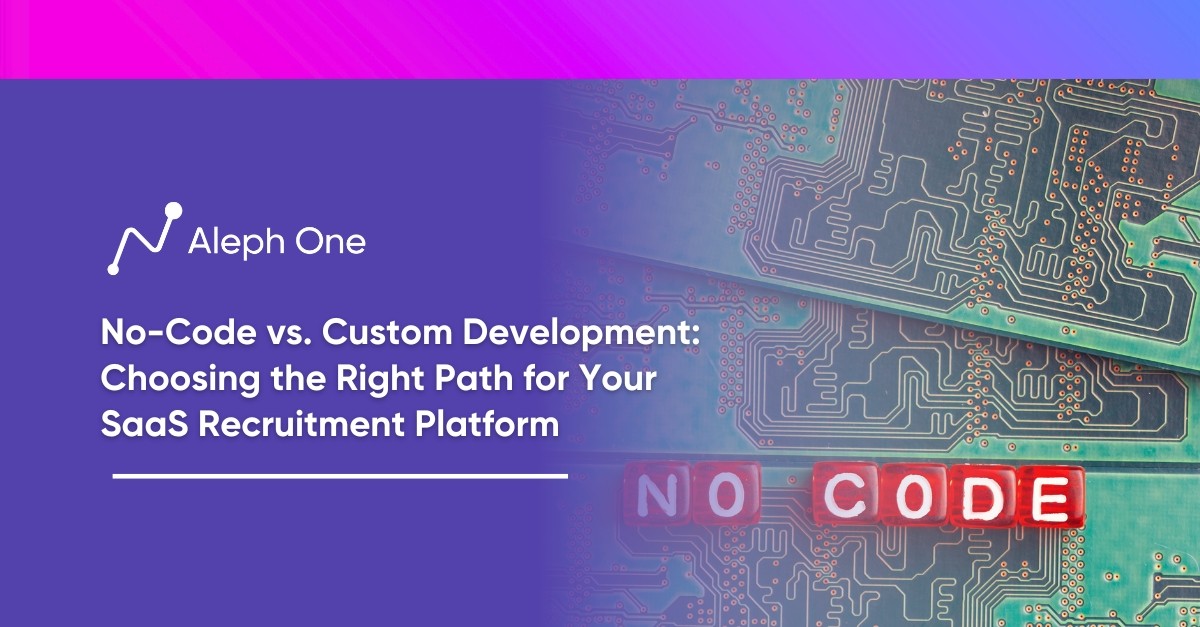Let’s work together to build something amazing. Share your project details and our team will reply to figure out the next steps to your success.

The world of software development is experiencing a revolution with the emergence of no-code platforms, allowing individuals without technical expertise to build applications. A shortage of software engineers, modular software architecture, and the success of automation and integration platforms has driven the rise of no-code tools. The no-code market has exploded, with over 50% of companies utilizing these tools and venture funding reaching billions. No-code tools have democratized software development, enabling rapid experimentation, faster product iteration, and decentralized development within organizations. However, custom development still exists in complex projects requiring specialized programming, regulatory compliance, or a competitive edge. In this article, we explore the benefits and limitations of both approaches and guide you in choosing the right path for your SaaS recruitment platform.

The Rise of No-Code: How New Tools Are Disrupting Software Engineering
In recent years, a new class of tools known as “no-code” platforms has emerged, enabling people with little to no technical background to build software applications. No-code platforms provide visual interfaces and logic frameworks that remove the need to write code. This allows almost anyone to become a maker and build web apps, mobile apps, and software automation without learning to code.
Zapier and IFTTT
There’s a growing need for more software engineers relative to demand, creating a need for alternatives to traditional coding. Second, the software has become more modular and easier to assemble without coding. Like Zapier and IFTTT have shown how automation and integration can be achieved.
The No-code Market has Exploded
According to a 2020 survey by Anthropic, over 50% of companies are now using no-code tools, and the number of platforms has topped 300. Venture funding for no-code startups tripled in 2019 to $1.2 billion. Some of the leaders in the no-code space include Appian, Airtable, Zapier, Webflow, and Bubble.
Lowered Barrier to Software Innovation
No-code tools have significantly lowered the barrier to software innovation. Almost anyone with a creative idea can now achieve what once required specialized technical skills. This enables more rapid experimentation and prototyping, faster product iteration, and more decentralized software development within organizations.
While still a developing trend, no-code platforms are poised to transform how software is built fundamentally. They promise to expand the creator class, accelerate digital transformation, and change the dynamics of software engineering talent.
Why No-Code is Not Just for Amateurs Anymore
No-code platforms have evolved far beyond simple tools for beginners. Many are now robust platforms large companies use to build sophisticated software without coding. For example, Airtable, a popular no-code database tool, is used by major companies like Netflix, BuzzFeed, and Chipotle to build custom internal apps. Bubble, another no-code platform, has been used by big brands like KLM, Walgreens, and Virgin to create public-facing web applications.
Build Prototypes and Applications Without Code
As no-code tools have become more powerful, they have enabled professional developers, product managers, and business analysts to prototype and build applications without writing code. This allows for much more rapid experimentation and iteration. Teams can get feedback on multiple versions of an app in the time it might take to build just one with a traditional engineering approach.
Software Creation
No-code platforms also open up software creation to people with domain expertise who need more technical experience. Someone who understands a business process inside and out can now translate that knowledge into an application with little help from developers. This domain-driven development allows for software better tailored to users’ needs.
No-code is Democratizing Software Development
While no code will not replace traditional software engineering altogether, it is making developers more productive and broadening who can participate in building software. Many see the rise of no-code as analogous to the introduction of graphical user interfaces, which opened up computing beyond just highly trained technicians. No-code is democratizing software development similarly.
Enterprise-grade Web or Mobile Applications are More Accessible
With robust no-code platforms, building an enterprise-grade web or mobile application is now within reach of almost any organization. No code enables a kind of “citizen development” where people across a company can create and modify applications to meet their needs without putting undue strain on central IT teams. This ability to spread software creation throughout an organization allows for more experimentation and innovation.
Faster and Collaborative Approach
No-code tools have evolved beyond toys for amateurs. They are enabling a faster, more collaborative, and more flexible approach to building software that leverages the skills and insights of people across an organization. While custom engineering will always have a place, no-code platforms are poised to become vital to any robust software development strategy.
The Hidden Costs of Custom Software Development
Custom software engineering projects are theoretically appealing but often struggle under unpredictable costs and schedules. Developing software from scratch requires thousands of hours of work from developers and engineers, and it is nearly impossible to estimate the total effort accurately. As requirements change and unforeseen challenges emerge, timelines slip and budgets bloat.
Custom Software Projects Often Overrun Budgets
The average cost overrun for a mid-sized custom software project is about 30 percent, according to research from the Standish Group. For larger projects, overruns of 50-100 percent are not uncommon. While new methodologies like Agile development aim to provide more flexibility, custom projects frequently miss deadlines by months or even years. The opportunity cost of these long development cycles is huge.
Sentinel – Budget Grew from $425 Million to $1.7 Billion
For example 2005, the FBI began developing a custom case management system called Sentinel for $425 million. By 2010, the budget had ballooned to $1.7 billion amid delays and setbacks. The project was finally abandoned in 2012, wasting years and hundreds of millions of dollars. Healthcare.gov, the US health insurance exchange website, is another infamous example of runaway IT costs and missed deadlines.
No-code platforms provide an appealing alternative to lengthy custom software projects by enabling rapid development and deployment. Simple apps can be built in days or weeks rather than months, and costs stay low thanks to the subscription-based pricing models of most no-code vendors. While code may only work for some use cases, it can be an excellent solution when speed and budget-friendliness are priorities. For software like business tools, workflow automation, and data dashboards, no-code allows companies to innovate faster and at a fraction of the cost. By reducing the time, money, and opportunity cost wasted on failed custom projects, no-code platforms have the potential to transform software development.
When Low-Code is the Right Choice
A low-code platform can provide the ideal balance of simplicity and customization for many software projects. Low-code tools provide a visual development environment with drag-and-drop components but also allow for additional custom coding to suit more complex needs. This flexibility makes low-code a good option when a no-code platform would be too rigid, but a fully custom build would be too time-consuming.
Simplify Development with Pre-built Modules
Major companies use popular low-code platforms like OutSystems, Mendix, and Appian to build internal tools, customer portals, and process automation systems. These platforms simplify development with pre-built modules for user management, data storage, and UI components. However, they also incorporate real programming languages like Java and C#, allowing developers to write custom code where needed. This ability to “open up the hood” and directly tweak the technology provides more flexibility than typical no-code platforms.
No-Code Solution for a SaaS Recruitment Platform
For a SaaS recruitment platform, a low-code solution could work well for building the initial tool, then allow for ongoing customization over time based on customer feedback or changes in the market. The speed of development is possible with low code would enable fast iteration while still providing the option to incorporate custom code for a tailored, differentiated solution. A low-code platform would also make it easy to build a front-end portal for candidates and a back-end system for recruiters and HR teams.
Low-code is ideal when a simple no-code tool won’t suffice, but a full custom software engineering project isn’t practical or cost-effective. It provides a shortcut to an initial working solution, then an easy path for ongoing enhancement and modification. Low code can be an excellent choice for any software that requires flexibility and the possibility of frequent changes, minimizing both the time and budget needed to achieve business goals.
Why Custom Code Will Always Have a Place
While no-code and low-code platforms continue to expand in capability, custom software engineering will always remain essential for specific projects. No-code and low-code tools abstract away much of the complexity of development, but they rely on pre-built components and logic that place some constraints on flexibility and control. Traditional coding is still the only option for highly complex use cases or where ultimate control and customization of the technology stack are required.
Custom Software – Machine Learning, Advanced Simulations, and Games
Some software can only be built with custom engineering. Machine learning algorithms, advanced physics simulations, and massive online multiplayer games are examples that require specialized programming. They push the boundaries of existing no-code and low-code tools. Artificial intelligence and virtual/augmented reality applications also typically need custom development to achieve their full potential.
Legacy system modernizations and migrations typically call for custom code. Integrating new platforms with older technologies companies want to retain requires tailored programming. No-code and low-code options may not be able to interface with some outdated systems. They also may not provide the specific functionality and workflows companies have built up over years of incremental changes to legacy software.
Highly Regulated Industries Require Custom Software
They have strict security, privacy, and auditing requirements that general-purpose no-code platforms may need to address. The risks of using a cookie-cutter solution in these industries are too high. Purpose-built code complies with all regulations.
Custom Engineering Competitive Advantage
Custom engineering is frequently the best approach for software that provides a competitive advantage. No-code and low-code tools are built for broad usage, so their applications may look and function similarly. To develop a truly novel piece of software that cannot be easily copied, custom code crafted to a company’s specific needs is typically required. This allows for the tightest integration with business processes and the creation of proprietary algorithms and workflows.
While no-code and low-code platforms continue to improve, custom software engineering will remain the gold standard for the most demanding, complex, and innovative projects. Custom development is likely the most appropriate approach for an SaaS recruitment platform dealing with sensitive data and requiring a tailored, competitive solution, despite the additional time and cost required. The flexibility, control, and customization far outweigh the benefits of an off-the-shelf no-code or low-code platform.
How to Choose the Right Approach for Your Needs
Determining whether to use a no-code platform, low-code tool, or custom software engineering for your project depends on several key factors. You must evaluate your needs around complexity, cost, time to market, flexibility, and available talent.
No-Code is for Simple Applications or Platforms
A no-code platform may suffice for a relatively simple SaaS application with standard functionality. It can get you launched quickly at a low cost. However, no-code likely won’t work if you have a complex product vision requiring highly customized features. No-code platforms also typically lack flexibility for extensive integrations or migrations.
Low-Code Tools for Simple and Complex Needs
Low-code tools are an excellent middle ground if you want more customization than no-code provides but still want to simplify development. Low code may be optimal if you have a mix of simple and complex needs, want to launch in a few months and have budget constraints. However, low-code platforms can still be limiting for the most sophisticated software projects. They may not justify the opportunity cost of building with a traditional custom approach.
Custom Software Engineering – Most Expensive and Time-consuming
Custom software engineering is the most flexible and powerful approach but also the most expensive and time-consuming. It is the only viable option if you have an extremely complex product, strict technology requirements, or need complete control over system architecture. The trade-off is that development cycles typically span many months and require a substantial upfront investment. Custom code is a significant undertaking that is only feasible for some organizations.
Launch Your Startup with No-Code or Low-Code Solutions
You must weigh all these factors for your unique needs and priorities. Think about both short-term and long-term requirements. And you don’t necessarily have to choose only one approach—you can often combine them for the optimal solution. With the right strategy, you can simplify development where you can and customize where you must.
Get the latest news and updates from Aleph One in your inbox.



